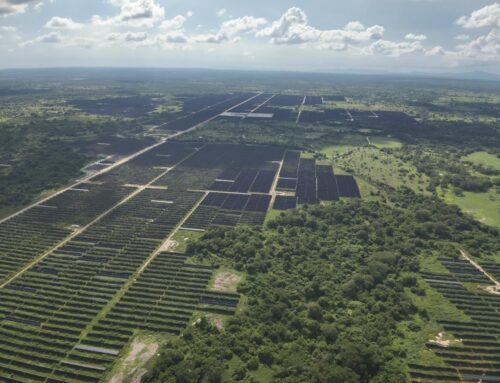Vast Energy advances world’s-first solar-powered green methanol demo
April 7, 2025

Maersk is leading the push to green methanol for shipping. Vast Energy’s South Australia Solar Fuels (SASF) could be a provider
Methanol has the lowest emissions of all the hydrocarbons. Using concentrated solar thermal energy to heat the thermochemistry to make it (instead of burning a fossil fuel to supply heat) and sourcing the input carbon from green sources would mean the global shipping industry could become carbon neutral.
The award-winning Australian company Vast Energy is the first solar thermal company to get close to building a green methanol demonstration project. Powered by Vast’s co-located utility-scale solar thermal project, VS1, it’s South Australian Solar Fuels (SASF) would have the capacity to produce 7,500 tons of green methanol annually.
Vast has just received $180 million from ARENA, around half the total needed to build VS1. Vast was also recently awarded a $700k grant from the Australia-Singapore Low Emissions Technologies (ASLET) initiative to continue development of the green fuels plant at its Port Augusta site. SolarPACES talked with CEO Craig Wood yesterday afternoon.
SK: Great news on the ARENA funding for VS1. What will the final round of funding enable?
CW: Our project is about demonstrating that the economics of green methanol, when powered by solar thermal, are compelling. The two projects in Port Augusta, the concentrated solar thermal plant and the green methanol plant it will power, are commercial reference projects. People can visit and get confidence that it is working and that it is low risk because it has already been done. That is the whole purpose of Port Augusta. The expectation is that once they’re up and working, things become significantly more straightforward to get over the line because you’ve got those reference sites that people can come and visit.
SK: How do you make methanol using solar heat?
CW: How you make methanol is not a secret. Currently, it is produced primarily using natural gas as a feedstock for carbon and to heat the thermochemistry. But we are just taking hydrogen from splitting water to create hydrogen and then combining that with biogenic carbon dioxide in methylation and distillation processes. So, what we are doing in terms of actual methanol synthesis is not particularly revolutionary. We are using existing technologies but taking advantage of the cheap green heat that Vast’s technology produces and the abundant renewable electricity available in South Australia to create cheap green methanol.
SK: How did you come up with the idea of using your proposed concentrated solar thermal plant to make green methanol?
CW: The genesis of the methanol plant came out of a cooperation between the Australian and German governments. Essentially, a request was put out for projects that could take Australian renewables and turn them into liquid fuels for consumption in Germany. So, it is very much a cooperative effort between Australians and Germans to create an industry here in Australia where we can export significant volumes of fuel into continental Europe.
SK: Is there any more research needed?
CW: No. For several years, our technology has not been in the research realm. Almost everything we’re doing now is focused on commercial deployment, making it more industry-focused than university-level research. The mix of people who we engage with has changed over time, as you would expect for a business moving from technology development into deployment. We’re working very closely with Mabanaft, a major German fuels business, as our 50/50 partner in the methanol plant and they’ve been terrific to work with.
SK: How big an industry need is methanol, especially if it was adopted to green up shipping?
CW: Methanol is an existing chemical that is extensively traded, with the market exceeding USD30 billion in 2023. However, it is poised to grow substantially as major international shipping firms like Maersk and CMA CGM have ordered many new vessels that use methanol as a green fuel.
SK: So the sky is the limit for using solar heat and biogenic carbon to decarbonize methanol with major international firms like Maersk on board…
CW: Exactly!
SK: Does SA Solar Fuels at Port Augusta de-risk future projects in your pipeline, such as Project Bravo in the US?
CW: Yes. In the fourth quarter of last year, we entered a development partnership with a Houston-based project developer, GGS Energy. We’re working with GGS to firm up the project configuration and economics, and then settle on the right site that has a combination of geographic features and grid, water and rail access – all of those things that need to come together for the site to be appropriate.
That will be a much larger version of what we are doing in Port Augusta, but it is in it’s very early stages. It depends on getting the Port Augusta plant financed, built, and operating first before we pull the trigger on Project Bravo. Seeing our Port Augusta demo working will make it easier to develop, finance and construct Project Bravo.
SK: Where would Project Bravo be in the US?
CW: We are looking at various sites, primarily around the West Texas area.
SK: Does a green methanol plant need to be near a fuel shipping port?
CW: Our Port Augusta demonstration green methanol plant will only produce 7,500 tons per annum, so that will most likely be moved by rail. When you’re doing a much larger plant, port infrastructure becomes more important. It is just a liquid fuel that can easily be moved, in the same way that people currently move gasoline or diesel by ship.
SK: So, with this $180 million from ARENA, you are now well on the way to generating green methanol with concentrated solar thermal power.
CW: We are thrilled to have the continued support of ARENA and we’re now working with other sources of capital to finalise the rest of the funding for the plant. We look forward to working with ARENA and our other partners to ensure that we can reach financial close and build and operate both VS1 and the co-located green methanol project.
SK: Might any future government understand the potential of Australian green methanol produced with concentrated solar thermal power?
CW: The reality in Australia is that PV, wind, and batteries are now proven, established technologies after decades of cost reductions and learning, and that is great. But other technologies, such as concentrated solar power, will still be needed for direct heat and dispatchable, long-duration thermal energy storage that comes with a plant like ours.
Everyone understands that it is essential that we continue to invest in and roll out those technologies. The really pleasing thing for us is that we continue to receive support from the Australian government via ARENA funding. Ultimately, that support is going to be critical in allowing us to build these plants and operate them, so we are really grateful for that.
Search
RECENT PRESS RELEASES
Related Post



